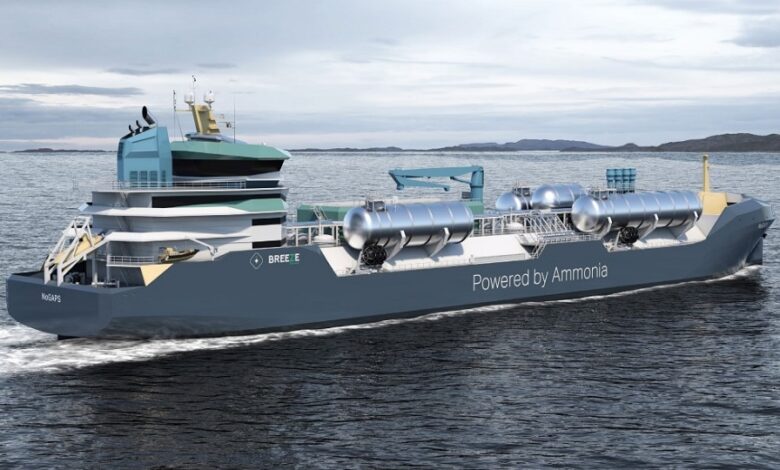Shipping shown path for ammonia-powered gas carriers from 2026

A new study released by the international not-for-profit organisation Global Maritime Forum has identified possible pathways to commercialise a first-of-its-kind ammonia-powered gas carrier as early as 2026.
As part of the Nordic Green Ammonia Powered Ship (NoGAPS) project, which is co-funded by Nordic Innovation and brings together Yara International, BW Epic Kosan, MAN Energy Solutions, Wärtsilä, DNV, Maersk Mc-Kinney Møller Center for Zero Carbon Shipping, and the Global Maritime Forum, the study laid out an “ambitious but feasible” set of actions that companies and policymakers could take to make a handy-sized gas carrier cost-competitive before 2030 with the right combination of ship finance, appropriate chartering agreements, and public sector de-risking measures.
Ammonia-powered gas carriers are seen as 50% to 130% more expensive to own and operate than their conventionally fuelled counterparts, which creates significant commercial risks for both shipowners and lenders.
The study, focused on the DNV-approved 22,000 cu m NoGAPS vessel, is the second stage of the project, which during the initial phase between 2020 and 2021 developed a holistic proof of concept covering ship design and safety, the supply of clean ammonia, and commercial viability.
As the key challenge is likely to be reducing the vessels’ elevated costs and related commercial risks to acceptable levels, the analysis found four interlocking levers that, if jointly pulled, could respond to this challenge and unlock suitable finance.
Based on input from banks and lessors, securing loans or leases should not only be available but be available on good terms without a significant risk premium.
This would need to be backed by an export credit agency, while access to a grant covering some of the additional capex of the vessel will be essential for shipowners to reach breakeven and improve the vessel’s chartering prospects.
The study, however, noted that while ECA backing is expected to be available, there is a shortfall in the capex support available for first-movers globally, adding that Norway’s Enova and the EU’s research, development, and demonstration (RD&D) schemes could potentially provide funding opportunities for the vessel.
Finally, the single most important requirement for investment and something that is expected to be a significant challenge for early ammonia-powered vessels will be securing a premium long-term chartering agreement with a creditworthy charterer.

“Charterers will bear much of the additional cost of operating the vessel, including the fuel cost. To facilitate a long-term chartering agreement, this premium must be substantially reduced,” the study said.
The study examined whether and how the premium could be tackled and the results suggest that the cost gap can be closed by as early as 2026 on the vessel’s potential route between the US Gulf and Northwestern Europe and for it to bunker US blue and green ammonia, which could reach a premium of 2% and 3% already by this point.
The vessel could also approach cost parity by 2030, with a premium of no more than 10%, in other scenarios, including if it were to bunker with more expensive ammonia produced in Northwestern Europe, the 65-page report claimed.
The results were primarily driven by the significant policy progress made over the last two years. The hydrogen production credits under the US Inflation Reduction Act and EU Fit for 55 package would reduce the cost of the vessel in question by around 20% and 10% each, but the study stressed that to close the gap this decade, industry action such as sourcing the lowest-cost clean ammonia and slow steaming would make the largest contribution.
Overall, the results pointed to at least three potential pathways for commercialising the vessel. The simplest pathway would be for the vessel to bunker in the US. The second is to use blue ammonia during its initial years of operation before transitioning to green ammonia once the cost is reduced. The third path includes several possible extra cost reductions including a fuel subsidy, such as Contracts for Difference, which is being considered under the EU Innovation Fund; offsetting the remaining cost through the FuelEU Maritime pooling mechanism; passing the remaining cost on to the end customer as a small green premium; or the International Maritime Organisation (IMO) introducing a basket of strong mid-term policy measures in a timely fashion by no later than 2027.

“Since 2020, the NoGAPS project has brought together key industry leaders to progress an ammonia-powered gas tanker concept towards real-world implementation. With the completion of this latest project phase, we not only have a detailed ship design that could be used for a shipyard tender but also a feasible commercialisation pathways. We hope this boosts confidence amongst charter parties and investors to take steps towards the realisation of NoGAPS and other ammonia-powered vessels,” said Jesse Fahnestock, project director at Global Maritime Forum.
